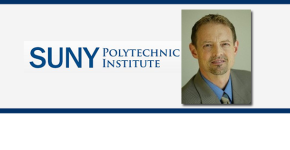 Technology management is a something of an abstract business concept.
Technology management is a something of an abstract business concept.
Robert Edgell, a professor of technology management at SUNY Polytechnic Institute, analyzes technology management from an architectural point of view.
Dr. Robert Edgell is an Assistant Professor of Technology Management at SUNY Polytechnic Institute and a Visiting Professor at the Swiss Business School in Zurich. Previously, he was a professor at American University’s Kogod School of Business and has taught at San Francisco State University’s College of Business.
His current scholarly research focuses on a range of interdisciplinary topics including media as a lever for corporate governance, responsible innovation and harm (in collaboration with colleagues from Stanford University Law School), top management team creativity processes, and entrepreneurial social impact.
Dr. Edgell received his Ph.D. in international multicultural management (magna cum laude) from the University of St. Gallen (AACSB accredited). He holds an MBA from Columbia University Business School in the City of New York and a Bachelor of Architecture (5 year degree, cum laude) from Kent State University. Through Columbia’s Chazen Institute of International Business, he studied at the Rotterdam School of Management in The Netherlands. He is a registered architect and has studied at Harvard’s Graduate School of Design.
Architectural Technology Management
![]()
I’ve always been fascinated with creativity and innovation.
I collaboratively conducted an ethnographic study of Architects. And guess what? Surprisingly, they are not the lone creative geniuses portrayed in popular culture. Instead, we found that they do more than just design buildings alone.
Architects work with others and deploy “paradoxical cognition”. This is a way of thinking used to arrive at acceptable tradeoffs among messy, conflicting and seemingly contradictory needs and constraints. Architects view these tensions arising from competing forces not as hindrances, but instead as opportunities to generate novelty and make better designs.
Furthermore, Architects collaboratively work through ensembles of diverse project constituents by using Interpretive Microprocesses or IMs. IMs such as charrettes and prototyping assist with information robustness by enabling the collection of not only verbal or language-based information stored in the brain, but also non-verbal, gestural, or visual information. This improves novelty generation and decision-making by reducing the incidences of judgment biases.
You might say the more robust the information, the better the decisions.
Thus, seeing innovation through the eyes of Architects provides insights about less-obvious dimensions that contribute to a more complete theory of sustainable change. With the right involvement from constituents, durable and creative buildings emerge—the same can be said of any organization.
Read More: SUNY Poly Blog: Campus Hosts Regional Innovation Challenge Event

Comments
One response to “Robert Edgell, SUNY Polytechnic Institute – Architectural Technology Management”